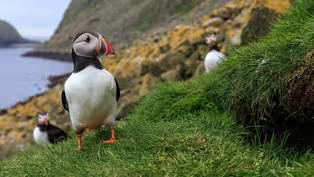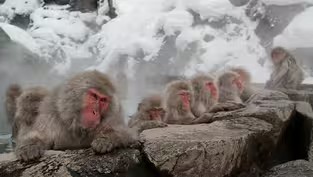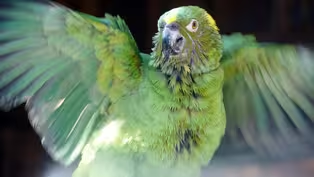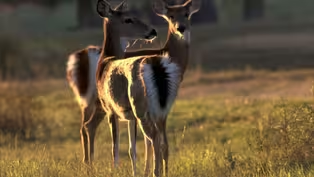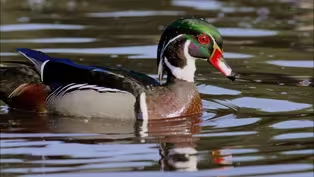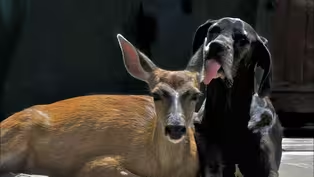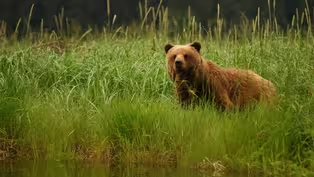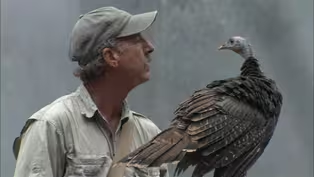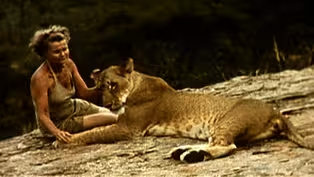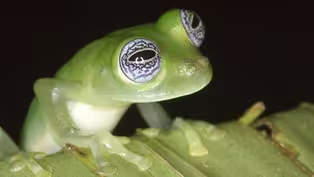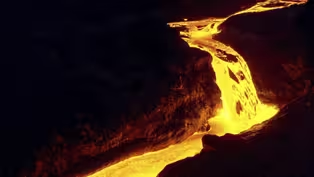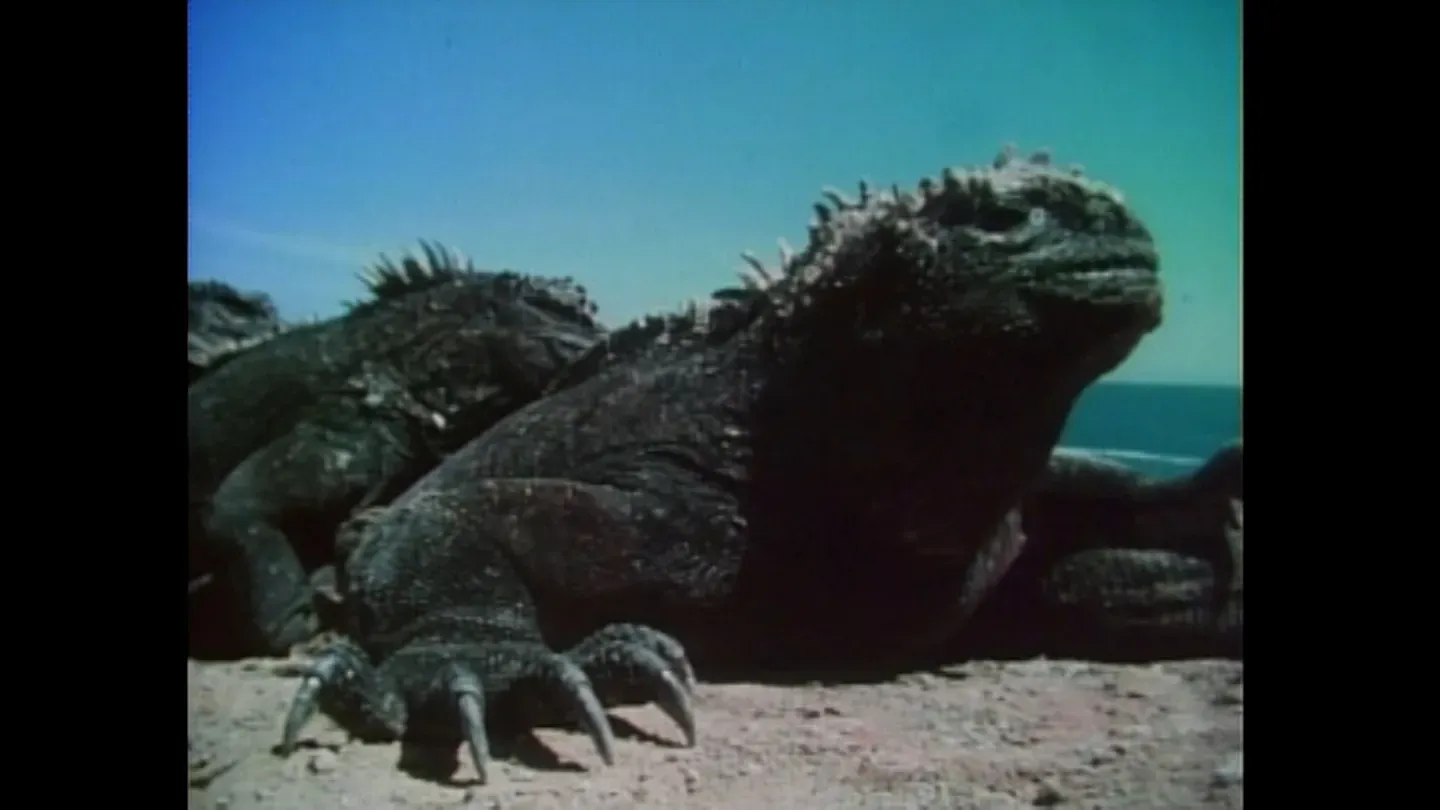

Perspectives of Paradise
Season 7 Episode 4 | 55m 47sVideo has Closed Captions
The Galapagos Islands and filming by D. Plage
A crew chronicles the process of wildlife filmmaking during a three-year study of the Galapagos Islands.
Problems playing video? | Closed Captioning Feedback
Problems playing video? | Closed Captioning Feedback
Major support for NATURE is provided by The Arnhold Family in memory of Henry and Clarisse Arnhold, Sue and Edgar Wachenheim III, The Fairweather Foundation, Charles Rosenblum, Kathy Chiao and...

Perspectives of Paradise
Season 7 Episode 4 | 55m 47sVideo has Closed Captions
A crew chronicles the process of wildlife filmmaking during a three-year study of the Galapagos Islands.
Problems playing video? | Closed Captioning Feedback
How to Watch Nature
Nature is available to stream on pbs.org and the free PBS App, available on iPhone, Apple TV, Android TV, Android smartphones, Amazon Fire TV, Amazon Fire Tablet, Roku, Samsung Smart TV, and Vizio.
Buy Now
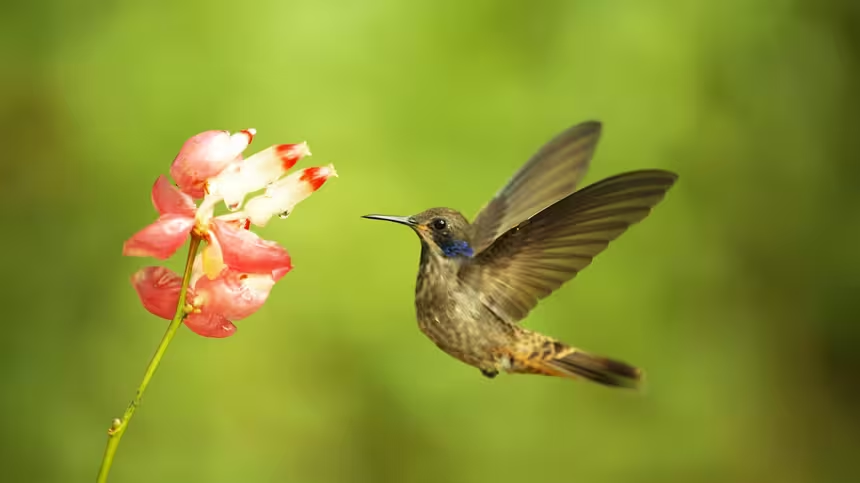
American Spring LIVE
Spring is coming to you LIVE on PBS! Find out how NATURE is celebrating the season of rebirth and how you can get involved as a citizen scientist!Providing Support for PBS.org
Learn Moreabout PBS online sponsorshipMore from This Collection
Video has Closed Captions
Animals congregate in huge colonies partly out of necessity and partly for the security. (52m 55s)
Video has Closed Captions
Follow a troop of snow monkeys in Japan to see how they prepare to face the world. (52m 58s)
Video has Closed Captions
Parrots and the bittersweet world they share with humans. (53m 10s)
Video has Closed Captions
Learning about one of our closest neighbors: the white-tailed deer. (53m 10s)
Video has Closed Captions
Take a fascinating look at one of our most familiar birds. (1h 42s)
Video has Closed Captions
Love apparently knows no boundaries in the animal kingdom. (53m 20s)
Video has Closed Captions
Enter a world shaped by bears, trees, and salmon. (50m 9s)
Video has Closed Captions
One man's remarkable experience of raising a group of wild turkey hatchlings to adulthood. (58m 51s)
Elsa's Legacy: The Born Free Story
Video has Closed Captions
The true story that inspired "Born Free". (53m 10s)
Video has Closed Captions
It is the greatest mass extinction since the dinosaurs. (53m 43s)
Video has Closed Captions
Kilauea, on Hawaii's Big Island, is the world's most active volcano. (54m 6s)
Video has Closed Captions
Relationships with cats and dogs are some of the longest and most intimate of our lives. (53m 30s)
Providing Support for PBS.org
Learn Moreabout PBS online sponsorship[plane whirring] [calm music] [bird cawing] [dramatic music] - Just a walk across a relatively new lava field is extremely difficult.
You have to watch every step and the jagged edges can cut your boots to pieces in no time at all.
Hi, I'm George Page for "Nature," and to wildlife filmmakers, each environment presents its own special problems and challenges.
In that great showcase of evolution, the Galapagos Islands, for example, the ground underfoot is largely volcanic lava rock like this.
The Galapagos animals evolved in splendid isolation without ever seeing or falling prey to humans and therefore they have little fear of us.
But because of the inhospitable terrain, getting to the animals was quite a different story.
This time on "Nature," we offer an unusual film about the making of a film, Dieter Plage's definitive three-part film study of the Galapagos Islands, the islands which inspired Charles Darwin's theory of evolution.
It took Dieter Plage three years to make these films but he's a wildlife filmmaker known for his persistence.
You'll soon discover why.
[dramatic music] When the production team, led by cameraman Dieter Plage, set out to make a series of wildlife documentaries in the Galapagos Islands, they faced many problems.
One was that apparently there was no way of getting a bird's eye view of one of the weirdest landscapes on earth.
In solving this and many other problems, they gained new perspectives of this Pacific paradise.
Their cameras were soon able to record for the first time what the soaring Galapagos hawk could see over the wild landscape of lava and volcanoes.
This is the behind the camera story of the trials, tribulations, and adventures that the team experienced in bringing to television the natural dramas of the Galapagos.
[triumphant music] One reason for their success was that in a group of islands where there are no light aircraft, they devised a way of being able to film at low level from the air.
[plane whirring] The machine, which added another dimension to their filming, was this ultralight aircraft rigged as a float plane.
In islands where there are no landing strips, Dieter Plage was now able to come and go almost as freely as a Galapagos hawk.
The Galapagos lies 600 miles out in the Pacific from the coast of Ecuador, the country which owns them.
There are 13 main islands.
Four of them are sparsely inhabited.
Wildlife films had been made there before but no one had been allowed to stay for three years to make a complete series on the islands.
Our camera team had been granted that privilege.
The Galapagos have a unique wildlife population which gave Charles Darwin, who visited the islands in 1835, vital clues to his theories on evolution.
The marine iguanas, for instance, the only seagoing lizards in the world.
The team had already completed a year's filming concentrating on iguanas and sea lions when the crates containing the ultralight arrived.
Before setting out for the Galapagos, Plage, who is an experienced light aircraft pilot, had taken a course in flying and maintaining the ultralight.
So had his wife, Mary.
Now they had to assemble a flying machine which is basically a sophisticated hang glider powered by a lawnmower engine.
Plage and his colleague, Friedemann Koster, assembled a little plane on the slipway of the Charles Darwin Research Station on the island of Santa Cruz.
Koster, scientific advisor and skilled wildlife cameraman, had just retired as director of the research station.
The team was fortunate to be able to use the station and its workshops as a base.
Though Plage had flown his own light aircraft in Africa and even in the Himalayas, he had never taken off from water before, let alone in the ultralight.
With considerable apprehension, he opened the throttle and a few yards later he was airborne.
[plane whirring] At first, he flew low.
It felt, he said, like sitting in a deck chair with wings.
Then, gaining confidence, he explored the jagged coastline of the island of Santa Cruz.
[calm music] He flew over a cruise ship on its way to the harbor of Puerto Ayora on Santa Cruz Island.
Puerto Ayora is more a sprawling village than a town, but it's the most heavily populated center in the Galapagos.
It's also the headquarters of the National Parks Department and the Darwin Research Station.
The first flight went well.
Now the ultralight had to prove whether it could provide the first low level aerial views of the islands.
It was essential to discover how the little plane flew fully loaded.
Plage took off with Koster as his passenger.
Although the aircraft remained under control, Plage decided that in the uncertain conditions of the Galapagos, it would be safer to fly alone.
Next, the passenger seat was removed and a camera tripod fitted in.
But this upset the balance so badly that the first attempt nearly ended in disaster.
[plane whirring] A hurried landing just, but only just, saved the day.
- It's impossible, I think.
- [George] So a less cumbersome mount was produced in the Darwin Station workshops and the ultralight trimmed accordingly.
This time, she flew perfectly.
Aerial photography could now, so to speak, get off the ground.
[calm music] Important as aerial photography is, it's really only the icing on the cake.
99% of a wildlife film is shot at ground level or sometimes at sea level.
In the Galapagos, it's often hard to tell where one ends and the other begins.
Every living thing in the islands is influenced and affected by the seas that surround them.
Every filming expedition to one of the islands had to be a self-supporting amphibious operation.
Galapagos sea lions are some of the friendliest creatures on earth.
The beach master, the dominant bull, is the only one to resent the intrusion.
[sea lion barking] Islands like Espanola are uninhabited, isolated, and they lack fresh water, food, or shade.
So the team had to bring everything ashore with them.
This time, for a three week stay.
[sea lions barking] The Galapagos lie on the equator and may look like a tropical island paradise.
The sunlight, however, magnified by reflection from the sea, is punishing.
Unless you can rig some shade, you'll fry.
So this becomes a first priority, not only to protect the team members, but their film as well.
In the tropics, early morning and late afternoon are the best times for filming.
Between those hours, wildlife and even the sea seem to go to sleep.
Early morning light on Espanola produced some literally golden filming opportunities.
[sea lions barking] Most successful wildlife filmmaking is the result of planning and patience.
But occasionally the cameraman just happens to be where something unusual and exciting happens.
Like these sea lions porpoising.
It's one of the rewards of being able to stay for a long time in one location, no matter how uncomfortable.
And living conditions in the Galapagos are seldom comfortable.
There's one aspect of Galapagos filming that's very much in the cameraman's favor.
Because they have no fear of man, the creatures there are incredibly trusting and approachable.
With one exception, the beach master bull, which will challenge any rival.
[water splashing] Plage took advantage of the beach master's aggression to get some unusual angles of a big sea lion bull charging.
[sea lion barking] The exceptionally trusting nature of Galapagos creatures is demonstrated by these blue-footed boobies displaying.
No need for a cameraman's blind here.
Team member Sylvia Harcourt could sit recording courtship behavior right in the middle of the booby colony.
Other aspects of the boobies' life are far harder to capture.
For instance, what do they look like underwater when they dive to catch fish?
You could sit on the bottom with an underwater camera for a year and still not be in the right place.
On occasions, a little subterfuge is called for.
To get shots of young boobies learning to dive, a red fishing lure was towed behind the rubber dinghy.
[boobies cawing] Here's what a mass dive on a shoal of fish by adult boobies looks like.
But to be beneath the waves with a camera when such an event takes place would require incredible luck.
[waves rushing] During their stay on Espanola, the team had a unique opportunity to film the courtship of the waved albatross.
It had to be unique because Espanola is the only place in the world where this species breeds.
Espanola is a flattop chunk of lava about four miles long.
There are so many nesting seabirds here that it's a little bit like a crowded aircraft carrier.
Just alongside the albatross colony nest the blue-footed boobies.
They're so close that sometimes they even incubate the wrong eggs, like this booby.
Dieter Plage's wife, Mary, is the stills photographer in the team, but she's also the planner and provider.
She had to make sure there was enough food for the four of them for the three week stay.
Checking the supply of fruit isn't made any easier by the curiosity of the Espanola mockingbirds.
[mockingbirds cawing] The mockingbirds are inquisitive about everything, even the camera tripod.
Sea lions in the camp kitchen are an everyday experience.
It's likely this was its favorite resting place before the team set up camp.
There is one never-ending source of fresh food, the sea.
For most of the year, Galapagos waters teem with fish.
Tuna, grouper, barracuda, and in this case, a fine fish called a wahoo.
The problem is that the team's day is so fully occupied that there's seldom time to go fishing.
It's important to have at least a few civilized amenities.
The midday meal of wahoo on this occasion is the only time when the team can relax.
Even then, the talk is always about today's or tomorrow's filming.
Sea lions find no problems about relaxing in the heat of the midday sun.
And with sea lions all around, there's never any shortage of helpers, or perhaps hinderers, when it comes to doing the washing up.
[water splashing] To get a sea lion's view of life, Dieter improvised a rig consisting of a life jacket, some lead diving weights, and a camera in an underwater housing.
This enabled him to film above and below the water at the same time.
[sea lion barking] The tidal pools gave opportunities to film marine iguanas grazing on seaweed beneath the surface, just as Darwin first recorded.
This was the first of several stays on Espanola.
They were to return later to film sea lions surfing and albatrosses learning to fly.
Even three years is hardly enough time to cover every wildlife event in the Galapagos.
Wear and tear on equipment is always severe.
Sand and lava dust get into cameras and outboard engines.
The team was lucky to have access to the workshops of the Darwin Station.
A wildlife cameraman has to be many things, including a good mechanic.
Distances between the main islands are mostly well outside the range of the ultralight, so the team had to hire a boat that could carry the plane as well as all their camera and diving equipment.
Their choice was Beagle IV, named after the ship that brought Darwin to the islands a century and a half earlier.
The present Beagle belongs to the Darwin Station.
Dolphins escorted her on her voyage, just as they must have done for the original Beagle.
[water splashing] Galapagos waters are not only noted for their perverse currents, but for violent Pacific swells that race in from the open ocean.
The ultralight did not take kindly to these, seeming to want to take off, aided by a strong headwind.
The little plane was not the only one to be troubled by the motion.
Only Poncho, the Beagle's cook, remained unaffected, cooking delicious meals under the roughest conditions.
The ultralight obviously longed to escape to its own element and had to be restrained by all hands.
The cook continued as if the Beagle was still quietly at her moorings in the harbor.
[upbeat music] [plane whirring] Not many sat down to Poncho's lunch that day.
[water splashing] The islands of the Galapagos rose from the seabed in fierce volcanic action that began 5 million years ago.
That action produced some very strange formations, including the Kicker Rock off the island of San Cristobal.
There's a narrow gorge that runs through the center of the rock with a fierce tidal surge welling through it.
The walls are covered with sharp barnacles.
Not many people have made the awesome voyage through that sea canyon.
[suspenseful music] But with care and respect for the turbulence, the pass can be navigated.
The same can never be said about walking over the jagged lava that covers the interior of most of the islands.
Practically every new wildlife location means a long exhausting march over this treacherous stuff.
But wildlife scenes like these made it worthwhile.
A red-billed tropic bird returning to its clifftop nest.
[bird cawing] A masked booby making a tricky touchdown.
A brown pelican diving for fish in the shallows.
[water splashing] Galapagos flamingos reflected in the calm waters of a brackish lagoon.
[water splashing] The awesome power of a killer whale looking for sea lion pups along the shore.
And the spindly dexterity of a ghost crab, excavating its burrow at low tide.
A male flightless cormorant, courting his mate with a bouquet of seaweed and mistaking Mary's camera leather for a similar offering.
A male frigatebird blowing up his red throat pouch to attract a female flying overhead.
[bird calling] And on Espanola, the waved albatrosses going through one of the most elaborate courtship rituals in the world of birds.
[albatrosses cawing] Perhaps the most fascinating bird that Plage and Koster filmed was the woodpecker finch.
By using a cactus spine or a twig to pry insects out of rotten trees, the finch qualifies as one of the few tool-using animals in the world.
Filming its behavior in complete detail took more than 2 1/2 months out of the three years needed to make the series.
The seas around the Galapagos play a vital part in the existence of their wildlife.
So it was inevitable that a large proportion of the team filming would be in or underwater.
Though the islands lie on the equator, there's very little coral, just jumbled lava on the sea bed.
The reason is that the currents are too cold.
Even so, they're very rich in food for fish, which in turn provide food for seabirds, seals, and sea lions.
When those currents fail, as they do occasionally, then the sea becomes a foodless desert and all wildlife suffers.
But for the moment, the cold Peru current that brings the sea's riches to the Galapagos was being kind.
Whenever the team dived, they found themselves surrounded by great shoals of fish.
Dieter Plage and Friedemann Koster had no trouble finding sharks for their cameras.
Happily, there's no record of a shark attacking a human in the Galapagos, probably because there are so many fish to choose from.
That menacing shape is a harmless manta ray, feeding on the plankton swarms.
Dieter and Friedemann were always worried about camera steadiness underwater, especially when filming small static subjects.
Fast moving sea lions are no problem.
[calm music] But the tripod proved its worth when filming some of the smaller members of the seabed community.
This little jawfish, for instance, which lives in an empty barnacle case and only pops out its head to feed or chase off rivals.
Nudibranchs are some of the most colorful creatures in the sea.
They're somewhat like marine slugs and move quite slowly.
Another ideal subject for the underwater camera mounted on a tripod.
They come in many shapes and colors.
You can't film planktonic creatures like salps in the open sea, even with a tripod.
They're far too small and completely at the mercy of the currents.
So members of the plankton swarms that form the base of all food chains in the sea had to be collected and filmed in specially designed tanks at the Darwin Station.
[calm music] During the making of any wildlife film, there are always setbacks.
A sudden fierce wind that caught the ultralight at its moorings and blown it on its back.
So they had to strip everything down, including the engine, and reassemble it.
In fact, the little aircraft created almost as many problems as it solved.
One of these was how to load it onto the Beagle IV when moving between islands.
Puffer fish nipping at one's toes and brown pelicans hoping to hitch a ride didn't make the operation any easier.
The problem was how to get the ultralight aboard without cracking its fiberglass floats.
It was always a delicate task, only partly solved by using inflatable rollers.
A better way had to be found.
When the team had been filming for just over a year, the yacht Ellendale arrived in the Galapagos and a new thread was unexpectedly added to the story.
Her skipper, Hal Whitehead, is a world expert on sperm whales.
He sailed halfway around the world to study the concentration of these huge threatened animals.
Whitehead believed they were still to be found off the most westerly of the islands.
His hunch proved right.
This was one of the grounds where the old time whalers had hunted sperm whales almost to extinction.
Now, the whales were back.
Though many experts had told Whitehead he wouldn't find any.
The four young scientists aboard the Ellendale were soon following parties of up to 40 whales day after day and recording their movements and behavior.
[whales calling] Whitehead agreed that Plage could film his research as part of the Galapagos story.
Plage found the filming of these huge peaceful creatures underwater one of the most moving and exciting experiences in his long career as a wildlife cameraman.
He also recorded their strange clicking calls.
[whales calling] It is thought that the clicks are a sonar device to help the whales find the squids on which they prey.
[water splashing] While filming these great marine mammals, they met another gigantic and harmless creature, the whale shark, the largest fish in the sea.
This 35 foot specimen swam beneath the Ellendale, deftly avoiding the vessel.
The whale shark, which feeds on minute marine organisms, is totally unaggressive.
It showed no objection when the divers got a tow by clinging onto its dorsal fin.
[dramatic music] A century ago, whaling played a tragic part in the story of Galapagos wildlife.
The British and American whalers took away or slaughtered hundreds of thousands of giant tortoises for food.
A happier relic of those bad old days is the barrel post office on the island of Floreana.
Passing ships deposited their mail in the barrel in the hope that another ship, homeward bound, would pick it up and deliver it.
Mary and Sylvia inspected the barrel in case someone from the Darwin Station had left them letters from home.
The names all around the barrel are those of ships which called here perhaps 50 years ago.
No mail today.
[mysterious music] While on the island of Floreana, Friedemann and Dieter heard of flooded tunnels and caves in the lava and decided to explore them.
It was a distinctly spooky business.
In the '30s, a self-styled baroness, one of the few settlers on the island, disappeared under mysterious circumstances.
There was even talk of murder.
Could the body have been hidden in these caves?
[mysterious music] The divers did find bones, but not those of the baroness.
These were the remains of the now extinct Floreana giant tortoise.
The great reptiles must have fallen into the tunnels and drowned or starved to death.
The problem of getting the ultralight aboard had at last been solved.
The team built a lifting platform on another boat, the Orca.
Problems with camera vibration were solved by building a mount on the front of the plane.
To stop the lens getting splashed on takeoff, they devised a movable cover from an old tuna fish can.
[people grunting] It had always been Dieter's plan to fly over the crater of the highly active volcano on Fernandina, the most westerly and least hospitable of the uninhabited islands.
Friedemann loaded his diving gear into the dinghy.
A bad landing of the often rough waters around Fernandina and the plane might sink with Dieter still aboard.
A backup team prepared to take up stations offshore.
[people speaking in foreign language] [water splashing] [plane whirring] - Copying you loud and clear, over.
[plane whirring] - [George] As Dieter well knew, a crash landing on the water was not the riskiest part of the enterprise.
The interior of Fernandina consists of jagged lava, which can cut boots to pieces within a mile or so.
You'd probably get away with a forced landing since the ultralight carries its own parachute.
But while trying to walk out over the lava flows, you could easily die of thirst.
Dieter recalls that flight over Fernandina.
- [Dieter] After 20 minutes, I climbed through the clouds and was fairly close to the volcano, yet could not see it.
I climbed higher, until I reached 7,500 feet and was well above the clouds.
Then, suddenly, Fernandina came into view.
It was an awesome sight, to look down into one of the most active and beautiful volcanoes in the islands.
[plane whirring] Soon it was time to head back.
As I descended rapidly, I passed over the rim.
The rising hot air from the black lava warmed by the sun created turbulence, shaking the little plane like a leaf.
It was an exciting adventure.
[calm music] [plane whirring] Flying low for the last few miles, I headed back to our little aircraft carrier.
In the following days, I flew over many of the island's landmarks.
Next, on the northwestern tip of Isabela, Volcano Ecuador, with Punta Vicente Roca, one of the most dramatic sights in the island.
Its 3,000 feet cliffs rise vertically from the sea.
Punta Vicente Roca is one of the favorite nesting sites of the blue-footed boobies.
[calm music] In Bartolome with the island of Santiago in the background, I could not resist flying through the gap between rock and pinnacle.
[calm music] Finally, Espanola with its dramatic cliffs from which the albatrosses take off against the southeasterly winds.
I had watched them many times as they hurled themselves over the edge of the cliff and wondered what it must look like to them.
Here it is.
Diving with a plane over the cliff edge, I attempted to recreate the albatross's eye view as it heads out over the ocean in search of food.
[calm music] - [George] Green turtles abound in the Galapagos waters.
To film them in a sheltered tidal pool, Dieter and Friedemann chose Derek's Inlet on the island of Isabela.
Galapagos penguins frequent the inlet also.
It seemed a perfect location with deep, still water.
But still waters don't always run clear.
When they submerged, the cameramen met an unforeseen difficulty.
The turtles were there, the water was clear, but somehow everything looked out of focus.
The explanation was that the pool contained layers of salt water and fresh water, which was welling out of the lava.
When these layers became mixed, it was like trying to film through a heat haze.
[calm music] Once the turtles headed out to sea, the water became clear again and the cameras recorded the scenes Dieter and Friedemann hoped for, the serene courtship of the green turtle.
[calm music] To film the giant tortoises of the Galapagos, you must climb to the rim of the volcanoes.
Everything has to be carried over some of the worst terrain on Earth.
This means that loads must be cut to the minimum.
The things you can't afford to cut down on are cameras and film.
The goal was the rim of Alcedo Crater on the island of Isabela.
Water, food, camping gear, and camera equipment, it all had to be backpacked with the help of porters.
At the start, the going was fairly easy, but finally, you have to face the lava fields and old craters overgrown with dense scrub.
The rim is only 4,000 feet above sea level but it feels like 40,000 by the time you get there.
[porter speaking in foreign language] - The right hand, to me, is not so bad, but the left one.
- [George] The porters who had helped carry the gear now went back, leaving the team alone to pitch camp on the crater rim.
Next morning revealed an almost prehistoric scene with giant tortoises half hidden in the early morning mist.
A Galapagos hawk perching on the back of a 300 pound tortoise gave Friedemann an idea for a new type of camera mount.
If he could fix a remote controlled camera to the shell of a tortoise, he might be able to get some very unusual tortoise eye views of the giant reptile's world as it moves through the scrub.
Unfortunately, it didn't quite work out as hoped.
This is the view he got briefly before the tortoise knocked the camera sideways as it blundered through the undergrowth.
Giant tortoises are somewhat like small tanks and just as unstoppable.
So when one decided to bulldoze its way across the camp, something had to be done to protect the precious water and food supplies, and of course the cameras.
Not that it would try to eat anything.
Tortoises are vegetarians.
But two or 300 pounds is a fairly irresistible force.
The tortoise had to be rerouted by Dieter and their Ecuadorian guide.
The tortoise returned to try its luck again.
This time, it was Mary Plage who saved the day.
After that, no one took any chances.
Everything was hung up in trees.
Heading back from the expedition along the western side of Isabela, they spotted a shoal of spinner dolphins.
If only the ultralight could be launched quickly enough, how marvelous they'd look from the air.
The plane was launched in record time.
[plane whirring] Friedemann followed at full speed in the dinghy.
[cheerful music] It was the kind of unexpected bonus you sometimes get when making a wildlife film, provided you're sufficiently geared up to take advantage of the opportunity.
The team's most rewarding subjects, Dieter picks the sea lions.
- [Dieter] Almost everybody has seen sea lions in zoos or circus.
We were fortunate enough to get to know them on Espanola Island in the Galapagos where they live in complete freedom.
It was so impressive to see them, particularly as water acrobats and masters of surfing, that we just had to try to follow them underwater with our cameras.
We thought there were only two ways in which to film them in the environment beneath the waves, either heavily weighted with lead and anchored to the bottom or free drifting with the currents and pounding waves.
Either method involved considerable risk for us and our cameras.
Despite inevitable cuts and bruises, we chose to free drift.
Our experiences which followed exceeded all our expectations.
The sea lion underwater surfing sequence was one of the most difficult and hazardous to do.
We worked on it over a period of three weeks.
We wanted to film them from under the waves as they were surfing in the shallow water.
[water splashing] This is fun for sea lions, but not for us.
We were thrown around and ended up with ripped wetsuits and lots of cuts and bruises.
It was, however, incredibly exciting as the huge waves rolled over us.
To me, the underwater sequence of sea lion surfing was the highlight of the film and a fitting tribute to the wonder which is Galapagos.
[gentle music] - [George] The end result of the survival team's extraordinary efforts represents the definitive film study of Charles Darwin's remarkable islands.
[dramatic music] [birds calling] [calm music] [water splashing] [waves rushing] [cheerful music] [sea lions barking] [calm music]

- Science and Nature

Explore scientific discoveries on television's most acclaimed science documentary series.













Support for PBS provided by:
Major support for NATURE is provided by The Arnhold Family in memory of Henry and Clarisse Arnhold, Sue and Edgar Wachenheim III, The Fairweather Foundation, Charles Rosenblum, Kathy Chiao and...
